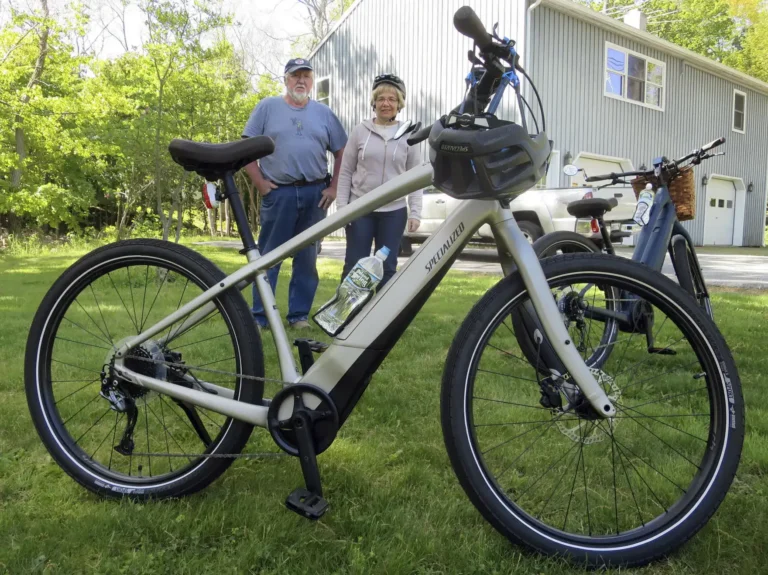The Ultimate Guide to Electric Bike Battery and Charging
Electric bikes (e-bikes) are becoming increasingly popular as a sustainable and efficient mode of transportation. A crucial component of e-bikes is the battery, which powers the bike and determines its performance. This guide will explore various aspects of electric bike batteries, including types, specifications, charging methods, and performance. We will also discuss the importance of battery voltage gauges and how to interpret their data. By understanding these elements, you can ensure your e-bike operates efficiently and safely.
Electric Bike Battery and Charging: Types and Specifications
Overview of Different Types of Electric Bike Batteries
Electric bikes (e-bikes) rely on batteries to provide the necessary power for propulsion. Different types of batteries are used in e-bikes, each with its unique characteristics. Below is a brief description of the most common types of electric bike batteries:
Lead-Acid Batteries:
Lead-acid batteries are the oldest type of rechargeable battery. They are commonly used in automotive applications and were among the first batteries used in electric bikes.
Pros: Inexpensive, readily available, and easy to recycle.
Cons: Heavy, low energy density, and shorter lifespan compared to other types.
Nickel-Cadmium (NiCd) Batteries:
Nickel-cadmium batteries were widely used before lithium-ion batteries became popular. They have good performance in various conditions but come with some drawbacks.
Pros: Longer lifespan than lead-acid batteries, better performance in cold weather.
Cons: Expensive, environmentally hazardous due to cadmium, and memory effect.
Nickel-Metal Hydride (NiMH) Batteries:
Nickel-metal hydride batteries are an improvement over NiCd batteries, offering better performance and being more environmentally friendly.
Pros: Higher energy density than NiCd, environmentally friendlier.
Cons: Expensive, memory effect, and shorter lifespan compared to lithium-ion batteries.
Lithium-Ion (Li-ion) Batteries:
Lithium-ion batteries are the most popular type for e-bikes due to their superior performance characteristics. They are used in various high-tech applications, from smartphones to electric vehicles.
Pros: High energy density, long lifespan, and lightweight.
Cons: Expensive and requires protection circuits to manage safety.
Lithium Iron Phosphate (LiFePO4) Batteries:
Lithium iron phosphate batteries are a subtype of lithium-ion batteries that offer enhanced safety and durability.
Pros: Very safe, long lifespan, stable, and fast charging.
Cons: Lower energy density compared to other lithium batteries, higher initial cost.
Specifications of Lithium-Ion Batteries
Lithium-ion batteries are the most popular choice for e-bikes due to their superior performance. Key specifications include:
- Voltage (V): Determines the power output. Common e-bike batteries are 36V or 48V.
- Capacity (Ah): Measures the amount of charge the battery can hold. Higher capacity means longer ride times.
- Energy (Wh): Calculated as Voltage x Capacity, it indicates the total energy stored.
- Weight: Lighter batteries are preferable for e-bikes to maintain efficiency.
- Lifespan: Typically measured in charge cycles. A good lithium-ion battery should last between 500 to 1000 cycles.
Pros and Cons of 48V Lithium-Ion Batteries
Pros
Cons
Comparison Chart: Panasonic, LG, and Samsung Electric Bike Batteries
Here’s a comparison of the popular battery types and their specifications from big brands like Panasonic, LG, and Samsung:
| Brand | Model | Type | Voltage (V) | Capacity (Ah) | Energy (Wh) | Weight (kg) | Average Cost ($) |
|---|---|---|---|---|---|---|---|
| Panasonic | NCR18650GA | Li-ion | 36V | 10Ah | 360Wh | 2.8 | $350 |
| Panasonic | NCR18650B | Li-ion | 48V | 13Ah | 624Wh | 3.2 | $450 |
| Panasonic | NCR21700 | Li-ion | 36V | 14Ah | 504Wh | 3.5 | $500 |
| Panasonic | LiFePO4 | LiFePO4 | 48V | 16Ah | 768Wh | 4.0 | $600 |
| Panasonic | 48V12AH | Li-ion | 48V | 12Ah | 576Wh | 3.0 | $400 |
| LG | MJ1 | Li-ion | 36V | 11Ah | 396Wh | 3.0 | $375 |
| LG | HG2 | Li-ion | 48V | 14Ah | 672Wh | 3.3 | $475 |
| LG | MH1 | Li-ion | 36V | 10Ah | 360Wh | 2.9 | $350 |
| LG | M50 | Li-ion | 48V | 15Ah | 720Wh | 3.7 | $525 |
| LG | 48V13AH | Li-ion | 48V | 13Ah | 624Wh | 3.2 | $450 |
| Samsung | INR18650-25R | Li-ion | 36V | 12Ah | 432Wh | 3.1 | $400 |
| Samsung | INR21700-50E | Li-ion | 48V | 14Ah | 672Wh | 3.5 | $475 |
| Samsung | INR18650-35E | Li-ion | 36V | 13Ah | 468Wh | 3.2 | $425 |
| Samsung | INR21700-48X | Li-ion | 48V | 15Ah | 720Wh | 3.6 | $500 |
| Samsung | INR18650-29E | Li-ion | 48V | 12Ah | 576Wh | 3.0 | $450 |
Most Popular Electric Bike Batteries in America, UK, and Canada
Here are the five most popular electric bike batteries in each country:
America
- Panasonic NCR18650B
- LG HG2
- Samsung INR21700-50E
- Panasonic NCR21700
- Samsung INR18650-25R
United Kingdom
- LG MJ1
- Samsung INR18650-35E
- Panasonic LiFePO4
- Samsung INR21700-48X
- LG M50
Canada
- Panasonic NCR18650GA
- LG HG2
- Samsung INR18650-29E
- Panasonic 48V12AH
- LG 48V13AH
Detailed Specifications of Popular Batteries
Panasonic NCR18650B
- Type: Lithium-ion
- Voltage: 48V
- Capacity: 13Ah
- Energy: 624Wh
- Weight: 3.2kg
- Cost: $450
LG HG2
- Type: Lithium-ion
- Voltage: 48V
- Capacity: 14Ah
- Energy: 672Wh
- Weight: 3.3kg
- Cost: $475
Samsung INR21700-50E
- Type: Lithium-ion
- Voltage: 48V
- Capacity: 14Ah
- Energy: 672Wh
- Weight: 3.5kg
- Cost: $475
Panasonic NCR21700
- Type: Lithium-ion
- Voltage: 36V
- Capacity: 14Ah
- Energy: 504Wh
- Weight: 3.5kg
- Cost: $500
Samsung INR18650-25R
- Type: Lithium-ion
- Voltage: 36V
- Capacity: 12Ah
- Energy: 432Wh
- Weight: 3.1kg
- Cost: $400
By comparing these popular models, you can make an informed decision on which battery suits your electric bike needs best, considering factors like voltage, capacity, weight, and cost.
Battery Charging and Maintenance
Different Types of Electric Bike Battery Chargers
There are several types of chargers designed for electric bike batteries:
- Standard Chargers: Provide a steady charge and are generally slower, taking 6-8 hours to fully charge a battery.
- Fast Chargers: Reduce charging time to 2-4 hours but may generate more heat, potentially affecting battery lifespan.
- Smart Chargers: Include features like auto shut-off when fully charged, trickle charging, and temperature monitoring to extend battery life.
Charging Protocols for Various Battery Types
Proper charging protocols can significantly extend battery life:
- Lead-Acid Batteries: Should be charged after every use and never left in a discharged state. Overcharging can cause damage.
- NiCd/NiMH Batteries: Avoid frequent partial discharges. It’s best to occasionally discharge completely and then fully charge to prevent the memory effect.
- Lithium-Ion Batteries: Should be charged before completely discharging to maintain health. Avoid overcharging and high temperatures.
How to Keep a Single Charge Strong and Extend Battery Life
To maximize the efficiency of a single charge and extend battery life:
- Proper Charging: Always use the appropriate charger and avoid overcharging.
- Temperature Management: Store and charge batteries in a cool, dry place. Avoid extreme temperatures.
- Regular Use: Batteries perform best when used regularly. Long periods of inactivity can reduce capacity.
- Maintenance: Clean battery contacts and ensure they are free from dust and corrosion.
Battery Voltage Gauges and Meters
Importance of Using a Voltage Gauge/Digital Meter
A voltage gauge or digital meter is crucial for monitoring battery health and performance:
- Prevents Over-discharge: Alerts you before the battery reaches a critical low level, preventing damage.
- Monitors Efficiency: Helps in understanding how the battery performs under different loads and conditions.
- Maintenance Indicator: Indicates when the battery needs servicing or replacement.
How to Install and Use Battery Voltage Meters
Installing a battery voltage meter typically involves:
- Selecting a Compatible Meter: Ensure the meter matches your battery voltage.
- Mounting the Meter: Choose a visible and accessible location on your e-bike.
- Wiring: Connect the meter to the battery terminals following the manufacturer’s instructions.
Using the meter involves:
- Regular Monitoring: Keep an eye on the voltage levels during rides.
- Interpreting Readings: Learn what voltage levels indicate full charge, optimal performance, and critical low levels.
Interpreting Data from Voltage Gauges
Understanding the readings from your voltage gauge:
- Full Charge: Typically, a fully charged 48V battery should read around 54.6V.
- Optimal Performance Range: For most e-bike batteries, this range is between 44V to 54V.
- Critical Low Level: Below 40V, the battery is critically low and needs charging.
Battery Performance and Costs
How to Measure E-Bike Battery Capacity
Battery capacity is measured in ampere-hours (Ah) and watt-hours (Wh):
- Ampere-Hours (Ah): Indicates the amount of current a battery can supply for one hour.
- Watt-Hours (Wh): Calculated by multiplying voltage (V) by capacity (Ah), giving a measure of the total energy stored.
Relationship Between Battery Size and Cost
Generally, larger batteries with higher capacity and voltage cost more:
- 36V Batteries: Less expensive, suitable for casual riding with shorter distances.
- 48V Batteries: More expensive, provide better performance and longer range.
Comparison Chart:
| Battery Type | Voltage (V) | Capacity (Ah) | Energy (Wh) | Average Cost ($) |
|---|---|---|---|---|
| Lead-Acid | 36V | 10Ah | 360Wh | $150 |
| NiCd | 36V | 10Ah | 360Wh | $250 |
| NiMH | 36V | 10Ah | 360Wh | $300 |
| Lithium-Ion | 48V | 12Ah | 576Wh | $600 |
| Lithium-Iron Phosphate (LiFePO4) | 48V | 15Ah | 720Wh | $800 |
Best Practices for Reducing Wire Sizes and Enhancing Battery Efficiency
Optimizing your e-bike’s wiring can enhance battery performance and efficiency:
- Use Appropriate Wire Gauge: Thicker wires reduce resistance and improve efficiency.
- Minimize Wire Lengths: Shorter wires reduce resistance and potential power loss.
- Secure Connections: Ensure all connections are tight and corrosion-free to prevent energy loss.
Conclusion
Understanding the various aspects of electric bike batteries and charging is crucial for maintaining your e-bike’s performance and longevity. By choosing the right battery type, following proper charging protocols, using voltage gauges effectively, and optimizing your bike’s wiring, you can ensure a smooth and efficient ride. Incorporating the principles of semantic SEO and topical maps can further enhance your knowledge and application, ensuring you stay informed and make the best choices for your e-bike needs.





